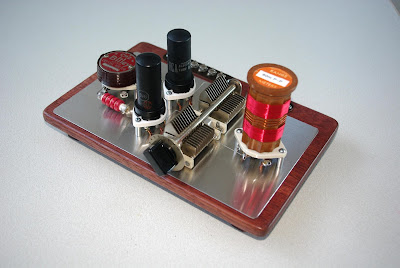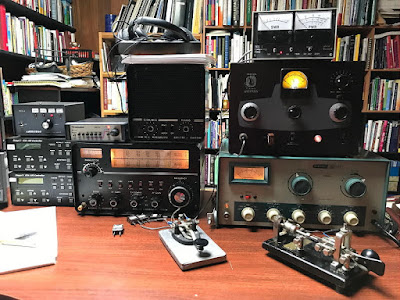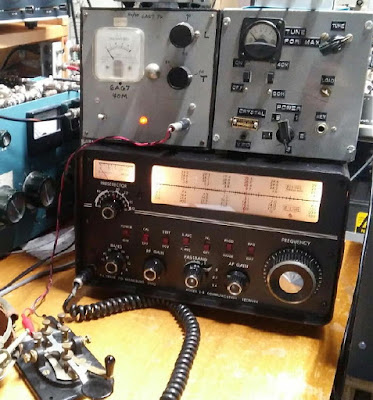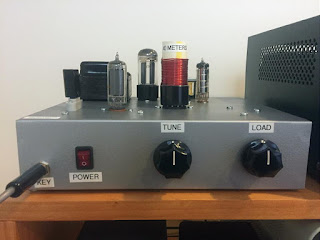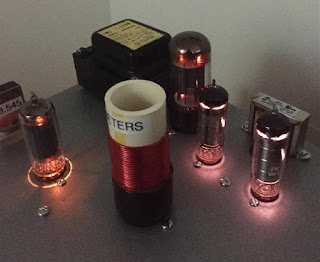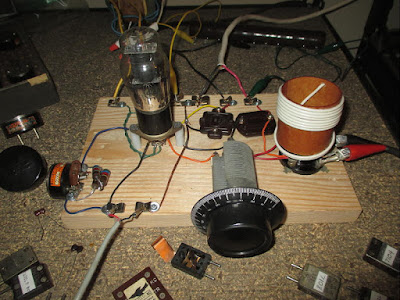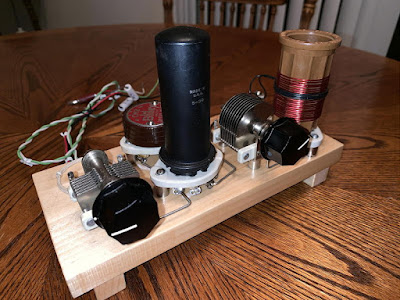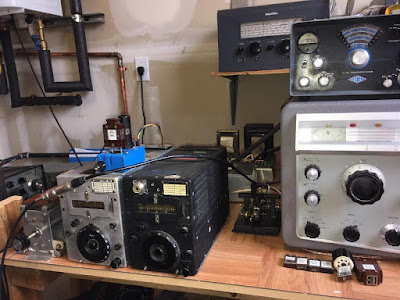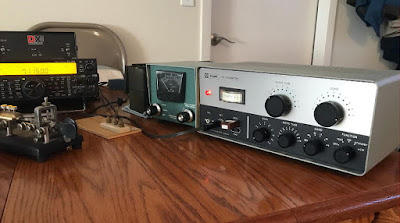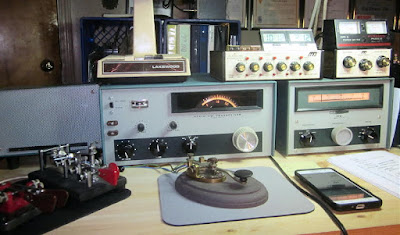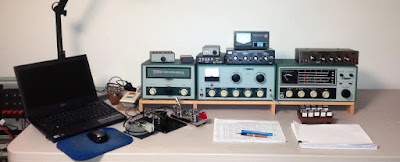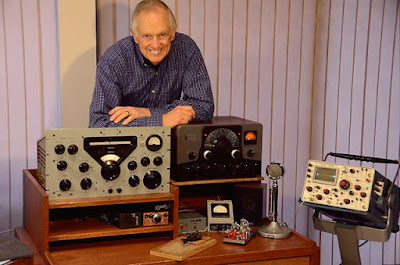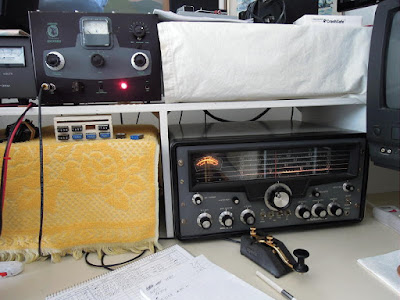 LHS Episode #276: Logical Volume Management Deep Dive
LHS Episode #276: Logical Volume Management Deep Dive
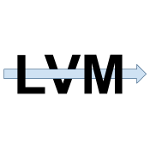
Hello and welcome to Episode 276 of Linux in the Ham Shack. In this episode, the hosts take a relatively in-depth look at the world of Logical Volume Management under Linux. LVM is a method for creating redundant, scalable and highly available disk volumes that can span multiple physical drives and media types. The topic is more immersive than could be covered in one episode but this should be a good initial primer for anyone looking to explore what LVM can offer. Thanks for listening.
73 de The LHS Crew
Russ Woodman, K5TUX, co-hosts the Linux in the Ham Shack podcast which is available for download in both MP3 and OGG audio format. Contact him at [email protected].
 ICQ Podcast Episode 289 – UHF/VHF Weekender Transceiver Kit Review
ICQ Podcast Episode 289 – UHF/VHF Weekender Transceiver Kit Review
In this episode, Martin M1MRB is joined by Chris Howard M0TCH, Martin Rothwell M0SGL and Frank Howell K4FMH to discuss the latest Amateur / Ham Radio news. Colin M6BOY rounds up the news in brief and this episode’s feature is a review of the UHF/VHF Weekender Transceiver Kit by Martin M1MRB.
ICQ AMATEUR/HAM RADIO PODCAST DONORS
We would like to thank our monthly and annual subscription donors for keeping the podcast advert free. To donate, please visit - http://www.icqpodcast.com/donate
- Radar makes 5 MHz Band 'Useless'
- Neil G0WPO - SOTA Mountain Goat
- Free Foundation Training Books for Australian Amateur Radio Students
- Radio Ham Takes on Department of Justice
- ITU Strengthening Emergency Telecommunications in the Americas
- GQRP Club Founder the Rev. George Dobbs, G3RJV, SK
- State of the Hobby Survey 2019
- BYLARA Launches New Bulletin Publication
- RSGB AGM Online Voting
Colin Butler, M6BOY, is the host of the ICQ Podcast, a weekly radio show about Amateur Radio. Contact him at [email protected].
 AmateurLogic 128: Windows 10 on Raspberry Pi
AmateurLogic 128: Windows 10 on Raspberry Pi
AmateurLogic.TV Episode 128 is now available for download.
George runs the full Windows 10 Pro (not IOT Core version) on the Raspberry Pi. Emile visits the W5DDL Hamfest in Rayne, LA. Tommy builds an Arduino Battery Monitor/Alert.
1:22:25
George Thomas, W5JDX, is co-host of AmateurLogic.TV, an original amateur radio video program hosted by George Thomas (W5JDX), Tommy Martin (N5ZNO), Peter Berrett (VK3PB), and Emile Diodene (KE5QKR). Contact him at [email protected].
 Part 3 of ham radio and condo life
Part 3 of ham radio and condo life
| Failed Hy-gain tape dipole |
Let me begin by saying this segment on antennas assumes you are looking for something that is either hidden or looks like something it's not.
Most (but not mine) town homes have a garage and driveway to-which you park a car in. I have found a very simple way to get on the air is to put an antenna on your car and run coax out to it. Now having said that you don't want to run around town with a huge antenna on your car (maybe you ...but not me) There are many fast connect/disconnect mounts on the market. As for the antenna I have seen and did have a multi-band HF antenna. I did operate my home HF radio with a multi-band antenna.....yes I did say I had no driveway or garage but more on that in a minute. The antenna I used was something similar to the Comet UHV-6 mounted on my car. There is also the Hustler triband adapter to allow 3 Hustler resonators to be used at the same time. With these types of antennas or similar ones you can run coax out to your car in the driveway connect to the antenna and your on the air.
In my case my townhouse at the time did not have a driveway or garage it was a common car parking lot. So what I did was I buried LMR 400 in plastic tubing out to where my car was. I terminated the coax to an SO-239 in a small plastic box. The box was in a small bush and unseen. When I wanted to go on the air I connected a small jumper of coax from the box to my car antenna. I was able to use this for about 3 years.
| Attic DX-EE |
| DX-EE stand offs |
| Weaving between rafters |
| Backyard side kick |
I did end up mounting the High Sierra sidekick antenna in the backyard close to our deck. It was in a very hard spot to see and I was able to remove the antenna when not in use and bring it in the house. I was able to conspicuously bury some radials and was able to get a decent SWR.
| High Sierra attic attempt |
| Mobile whip dipole |
 |
| Alex loop in living room |
Mike Weir, VE9KK, is a regular contributor to AmateurRadio.com and writes from New Brunswick, Canada. Contact him at [email protected].
 Amateur Radio Weekly – Issue 233
Amateur Radio Weekly – Issue 233

FCC looking for comments on enhanced Tech priveleges
This includes phone privileges at 3.900 to 4.000 MHz, 7.225 to 7.300 MHz, and 21.350 to 21.450 MHz and RTTY and digital privileges in current Technician allocations on 80, 40, 15, and 10 meters.
KB6NU
Keyless chaos as drivers mysteriously locked out of cars
Authorities are trying to locate the disruptive signal.
Southgate
Of end-feds and feed-lines
Simulations suggest what feedline lengths to avoid and offer a confirmation why portable users with short feeds never seem to have trouble.
hamradio.me
Top ten FT8 advantages for slackers
You have time to visit the restroom without missing any contacts.
K0NR
All about RF coaxial cable connectors
Many standard connector formats, such as the D-type connectors and many other multiway connectors consist of a series of pins with connections in parallel to each other. RF connectors are typically very different and have some rather different characteristics.
electronics-notes.com
3D printed telegraph
To actually put a key to use, you need a telegraph sounder on the receiving end to “play” the messages.
Hack A Day
Flooded batteries for off grid radio, revisited
Regular maintenance on flooded batteries should be done at least twice a year, or quarterly if your batteries are cycled often.
Off Grid Ham
Pistol crossbow antenna launcher
Generally, the higher you can get an antenna, the better off you will be.
Soliloquy Blog
Radio fun: Monitoring ISS answering student questions
The pass was high and mostly to my open south which meant it was one of the longest ARISS contacts I’m monitored.
The SWLing Post
2019 State of the Hobby Survey
This benchmark can help us determine what is working and what is not in the ham radio community. This can involve participation, recruitment, mentoring and licensing. It can also help identify new and emerging trends in amateur radio. Please take a few minutes to complete the survey and share with others in the hobby.
N8RMA
Video
Running two instances of WSJT-X
A demonstration of two instances of WSJT-X, two radios, and two antennas. One computer.
K0PIR
Get Amateur Radio Weekly in your inbox.
Sign-up here
Amateur Radio Weekly is curated by Cale Mooth K4HCK. Sign up free to receive ham radio's most relevant news, projects, technology and events by e-mail each week at http://www.hamweekly.com.
 LHS Episode #275: The Weekender XXV
LHS Episode #275: The Weekender XXV

You have tuned into the 275th episode of Linux in the Ham Shack. In this, the 25th Weekender episode, the hosts discuss upcoming amateur radio special event stations and worldwide contests, upcoming open source conferences, Linux distributions to try, challenges to try for yourselves, meatloaf that might just be murderous, an Imperial IPA and a port-finished bourbon along with many other topics. Hope you have a fun and inspired fortnight.
73 de The LHS Crew
Russ Woodman, K5TUX, co-hosts the Linux in the Ham Shack podcast which is available for download in both MP3 and OGG audio format. Contact him at [email protected].
 My 2019 Novice Rig Roundup Summary
My 2019 Novice Rig Roundup Summary

Once again the Novice Rig Roundup (NRR) has come and gone ... and once again, it was the most enjoyable 'contest' of the year for me.
What I have come to enjoy most about the NRR is that most participants do not really treat it as a contest but more as an opportunity to spend some relaxing CW time enjoying some of their favorite vintage rigs ... spread out over nine days of activity. Since there was never a Novice-class program in Canada, I was never a Novice, but the NRR brings back all of the good memories experienced as a newly-licenced radio-crazed 15 year old operator!
Back in those times, there was a gratifying sense of achievement with every contact. My clap-trap collection of parts and tin gutter-pipe verticals, mounted atop our old four-story city house, magically sent my tiny signal from coast to coast and over the pole.

Those were the dying days of big-daddy Cycle 19, and my station was proof that just a tiny bit of RF was all that was needed under such amazing solar conditions.
This year's NRR began by making a couple of contacts with my Drake 2NT and VF-1 VFO but my newly-finished 1936-style Jones Push Pull Oscillator was begging to be put to the test. This meant that the remainder of the week would be spent using crystal-control and in all likelihood, sending a hundred or more 'CQ NRR's, hopefully attracting some of the crowd.
Due to previous commitments, I missed a few nights of operating but ended up with 53 NRR contacts in 23 different states or provinces. Operating on 40m in the late afternoon and then for a short period on 80m after dinner, proved to be the best use of my time, as usually, much of the eastern activity had closed shop for the night, just as the band was getting good. There were two nights of superb 80m propagation but with very little NRR activity ... unfortunately for many participants, late-night operating (even with wonderful propagation) is not in the cards for those that must rise early for work the next morning!
There were several highlights for me once again and being able to create them while using my new homebrew rig was very gratifying.
Roger, VA1RST, back in Halifax, Nova Scotia, was one east-coaster that seemingly cherished the midnight-oil! His great Drake 2B ears were able to copy the little 'Jones' on 80m with no problem and his participation added an exotic DX-flavor to the NRR.
Michael, W3TS, managed to squeeze enough RF from his one-tube 6AG7 crystal oscillator to be heard and worked here on both 40 and 80m, with a respectable 559 on 40 and 569 on 80!
It wasn't until after the NRR was over that I realized why Mike's call was familiar as we had worked a couple of times already this winter on the 630m band (475kHz) ...doh!
More transcon magic was made when Tom, K3AJ, finessed a few watts from his single 6CL6 crystal-controlled DX-machine to the west coast on both 80 and 40m. The propagation gods must have been paying close attention as his 40m signal was a solid 579 while his late-night 80m signal was a whopping 589 here ... 80m propagation just like the good old days!
Not to be outdone by Tom, ex-Nebraskan Andy, KØSM in New York, kept his vintage '42' clipped together long enough to be worked back here as well. With just a couple of watts from the early '30s tube, his signal was no problem on both bands.
Gary, W8PU, with his newly-built mid-30s 6L6 tri-tet oscillator, was another treat from the east when his 559 80m signal arrived here from Ohio in good form.
A little closer to home, WB2AWQ, Howie down in Reno, had a whopping signal all week whenever I heard him on 40m. Howie can always be counted upon for 'NV' in most vintage rig operating events, including the 1929 BK Party. This time 'round, he was using his BC-458A, crystal-controlled at 35 watts out. It's a good bet that hundreds of Novices got their start with a surplus Command set such as this, which often sold for just a few dollars in the 50s ... still new in the box!
Even closer was new Oregonian, Dave, WB7WHG, who was still getting set up at his new location on the east side of the Cascades in Bend. Dave keyed his Knight T-60 for our NRR contacts on both 80 and 40 and was very much louder than when I used to work him at his midwest WB9WHG QTH!
The T-60 is a popular choice among NRR ops and it's diminutive size is somewhat misleading as the current-hungry sweep tube used in the PA stage packs a big wallop. If you happen upon one of these under a fleamarket table, don't pass it up ... it"s a lethal NRR weapon!
Heathkit stations were as popular in the NRR as they were in countless Novice shacks decades ago ... and they sound just as good now as they did back then.
KN8RHM (N8XI), Rick, made Michigan proud with his HW-16 transceiver, while Mark, VA7MM, handed out 126 contacts from western Canada with his all Heath vintage station. His newly added homebrew TR switching system provided hands-free break-in, saving wear and tear on the DX-60's precious function switch.
Not many Viking Rangers were heard this year but the one keyed by Markus, VE7CA, sounded very 50s-like with its oscillator being crystal-controlled for the event.
K9SB, Tim, used his Johnson Adventurer and Hallicrafters SX-101A vintage setup as well as a vintage Drake station to hand out 'IL' to many NRR ops.
There seems to be no shortage of era-appropriate Novice gear out there but as the years progress, it will get harder and harder to find and probably more expensive to own. It's wonderful to see so many amateurs that understand and appreciate this older gear and are doing their best to keep it all working ... and the NRR is just one of many opportunities to let these old beauties demonstrate their capabilities.
From what I can tell, NRR activity continues to increase every year and will hopefully be even bigger next year. If you were a participant, don't forget to get your log completed along with your photos and soapbox comments, all of which can be done through the NRR website here. If you enjoyed the NRR, all run by volunteers, consider making a small monetary donation to keep the event going. You can do this via the NRR site as well.
If you're one of the many NRR participants that didn't want the event to end, don't forget that every Monday is the NRN (Novice Rig Night). A short 'CQ NRN' in the usual CW watering-holes, will often provide some nice rag chew time with like-minded operators.
Thanks to all organizers and participants for the CW fun and for another great ride in the NRR time-machine ... see you again next year!
Steve McDonald, VE7SL, is a regular contributor to AmateurRadio.com and writes from British Columbia, Canada. Contact him at [email protected].

